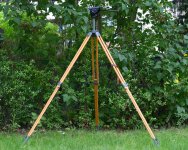I totally agree with WRL ; if your scope is being battered your head will be too - so a 100% stable scope might be no use. That's why I find a monopod so useful in windy condtions - my head and my scope go sideways in sync with every gust. It's a lot better than a scope and tripod.
If you lie flat on the ground on your front, hammer a metal spike into the ground in front of your head and somehow attach the tripod head to the top of the spike you might be OK in 50mph gusts

This is the sit-mat I always carry in my rucsac :
Folding Sit Mat | Mountain Warehouse GB
It's currently on offer at £5.99, weighs almost nothing and folds up to not a lot. It has foam padding. It's a lot smaller and lighter than a folding chair and 0.5m lower. Put it on your Christmas list ?









